Chord progressions are a succession of chords played one after another for a specific duration. In jazz, there are many similar chord progressions in different keys. From practicing simple jazz chord progressions, the process of learning jazz standards will become easier. A few examples of common jazz chord progressions piano are ii V I, I vi ii V, and iii vi ii V. If you want to break down jazz tunes and learn how to improvise over them, you need to master a few progressions. This guide includes 10 of the most used Jazz chord progressions, and will help you distinguish some of the most important progressions and their variations.

The Major ii-V-I
The most utilised chord progression found in jazz music is the major ii-V-I sequence. This Jazz chord progression is made up of three basic chords built from the first (I), second (II) and fifth (V) degree of the major scale.
Each degree corresponds to a chord, – this means we play a minor seventh chord on the degree II, a dominant seventh chord on the degree V and a major seventh chord on the degree I. Which makes in the key of C major: Dm7 (II), G7 (V) and Cmaj7 (I), which are three four-note chords built by stacking thirds.
| Dm7 | G7 | Cmaj7 |
| iim7 | V7 | Imaj7 |
One Chord Per Measure
You can find the ii V I progression with two chords per measure. The first example below uses two basic drop 2 chords.
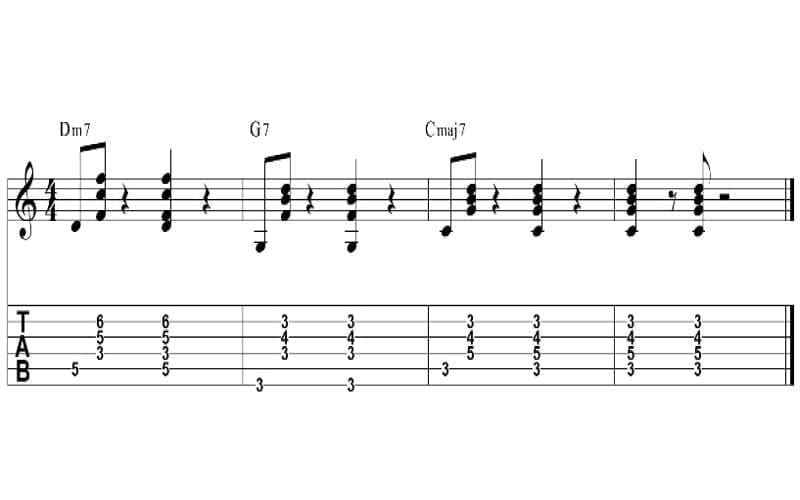
Examples of Jazz Standards That Use II-V-I Progressions
- Summertime (A-7, D7) Sometimes the II -V doesn’t resolve to the I.
- Autumn Leaves (A-7, D7, Gmaj7).
- Tune Up (E-7, A7, Dmaj7).
- All the things you are (Bb-7, Eb7)
- In a Mellow Tone (C-7, F7, Bbmaj7)
Jazz Chord Progressions The V Chord of a ii-V-I
As seen above, the II-V-I progression is very easy to play. It’s a smooth introduction to jazz comping. Although, only playing notes can be boring in the long run.
The next step is looking into another important jazz chord progression – the V7 as an altered chord (Valt or V7alt). It means that we will add altered notes not present in the original scale (the major scale). These altered notes are b9, #9 #11 (b5) and b13 (#5).
This will create tension, and an imbalance of the V7 chord which should resolve to the I chord to release this tension. The new progression is now ii-V7alt-I.
There is no change for the minor (II) and the major (I) chords. However, the V chord will undergo a few changes. They are:
| 7b13 | 1 | 3 | 5 | b7 | b13 | |
| 7b9 | 1 | 3 | 5 | b7 | b9 | |
| 7#9 | 1 | 3 | 5 | b7 | #9 | |
| 7#11 | 1 | 3 | 5 | b7 | #11 | |
| 7b13#9 | 1 | 3 | 5 | b7 | #9 | b13 |
| 7b13b9 | 1 | 3 | 5 | b7 | b9 | b13 |
| 7b5b9 | 1 | 3 | b5 | b7 | b9 | |
| 7b5#9 | 1 | 3 | b5 | b7 | #9 |
In this example, the V is changed with the b13 (Eb) which transforms into the major third of Cmaj7 (E).

In the next example, the V has an altered fifth in the bass, which resolves to the root of Cmaj7. This makes a downward chromatic bass line (D, Db, C) from Dm11 to Cmaj.

Jazz Chord Progressions The Minor ii-V-I Cadence
The minor ii -V-I chord is equivalent to the major II-V-I, but in a minor key. The jazz chord progression can be heard in many jazz songs including Blues bossa, Autumn Leaves, and Black Orpheus.
The chords are m7b5 (II), 7alt (V) and minMaj (I). The latter one is most of the time replaced by a minor 7 chord because it is a little bit dissonant. Jazz standards in minor keys are not common however, there are often minor II-V-I cadences within Jazz songs.
| Dm7b5 | G7alt | CminMaj7 |
| iim7b5 | V7alt | IminMaj7 |
Below is a C minor II-V-I sequence illustrated with three chords

Dim7 Passing Chords
| Cmaj7 C#°7 | Dm7 D#°7 | Em7 A7 |
| Imaj7 #I°7 | iim7 #II°7 | iiim7 VI7 |
The use of diminished 7 passing tones to connect the Imaj7 and iim7 chords is frequently used in jazz music and is an important harmonic device that can make things more interesting as a jazz guitarist. Dim7 sequences add harmonic tension to this progression.
Examples Of Jazz Standards That Use Dim7 Passing Chords
| Song Title | Played By |
| Cherokee | Tal Farlow |
| Have You Met Miss Jones | Kenny Burrell |
| Joy Spring | Joe Pass |
| But Beautiful | Lenny Breau |
| Ain’t Misbehavin’ | Django Reinhardt |
Below are two ways illustrating how you can on comp these important chords:
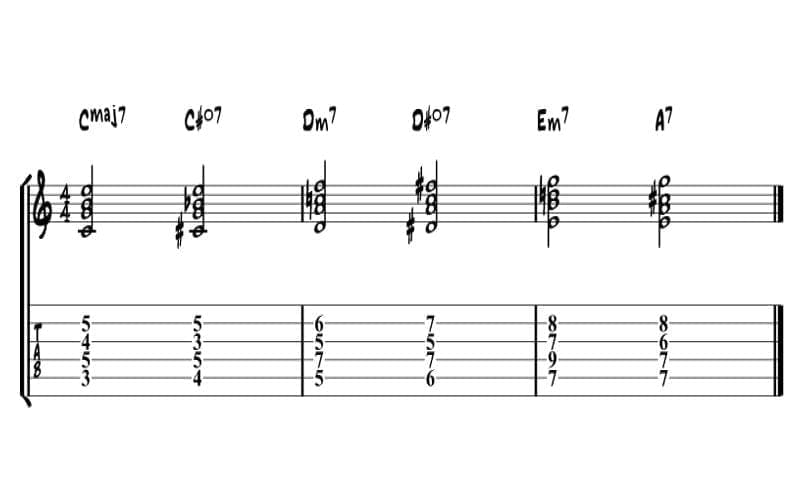

Take The A Train Chord Progression
| Cmaj7 | % | D7 | % |
| Imaj7 | % | II7 | % |
| Dm7 | G7 | Cmaj7 | % |
| iim7 | V7 | Imaj7 | % |
Mainly associated with the classic tune ‘Take the A Train’ from Duke Ellington, these chords are cool in sound as well as fun to play.
| Song Title | Played By |
| Take the ‘A’ Train | George Benson |
| The Girl from Ipanema | Charlie Byrd |
| Desafinado | Charlie Byrd |
| Mood Indigo | Kenny Burrell |
Below are two ways that you can work on these chords to help get them under your fingers.
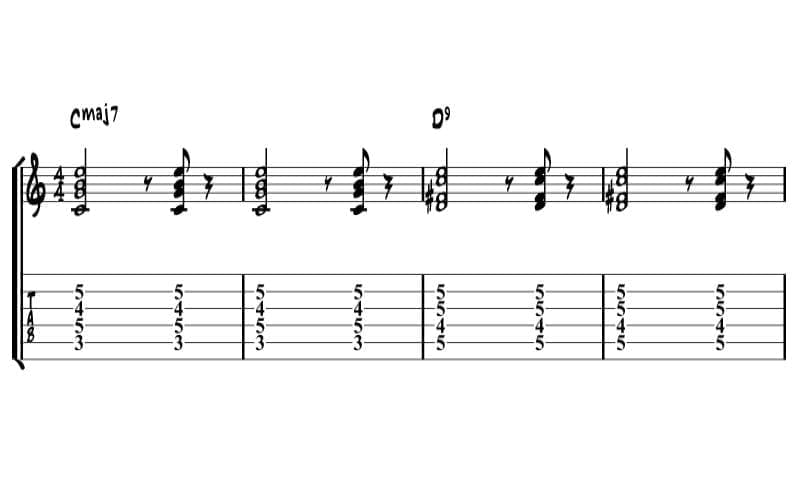
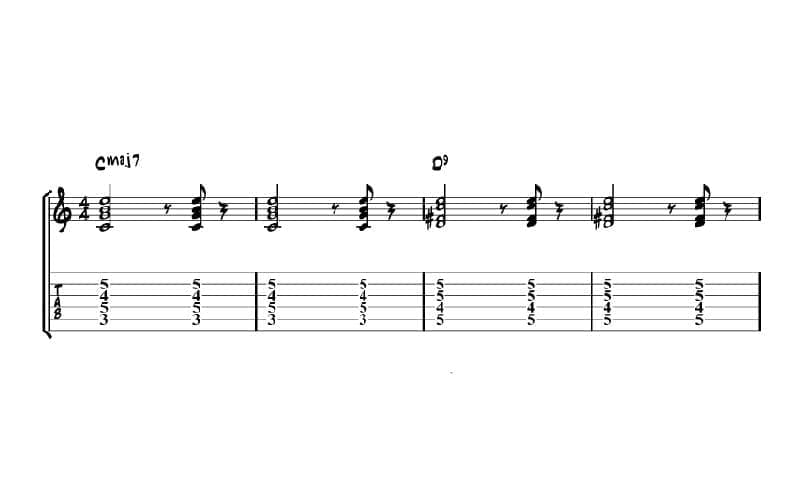
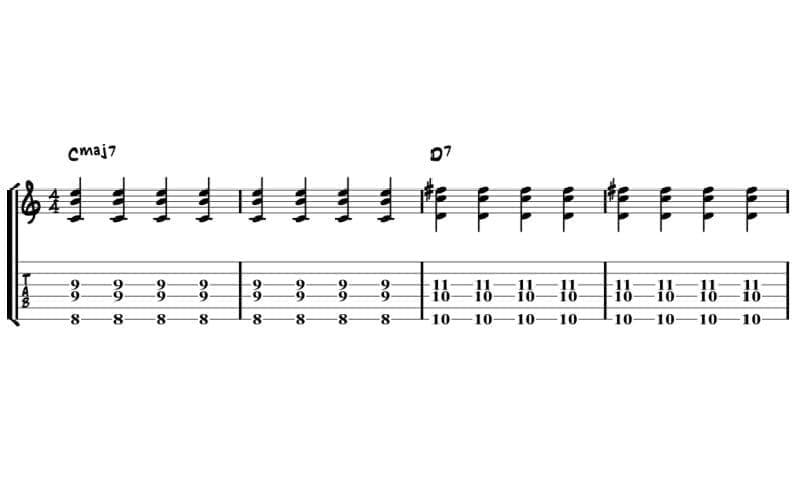

I to IV
In blues music, the movement from chord I to chord IV is usually used during the jazz guitar idiom. This movement can be used in a progression to a major key situation, however many have also used it as a jazz-blues standalone piece.
Examples
Here are the Jazz chord progressions piano from practicing the examples below, it will allow you to confidently bring the changes to your music sessions in no time at all.

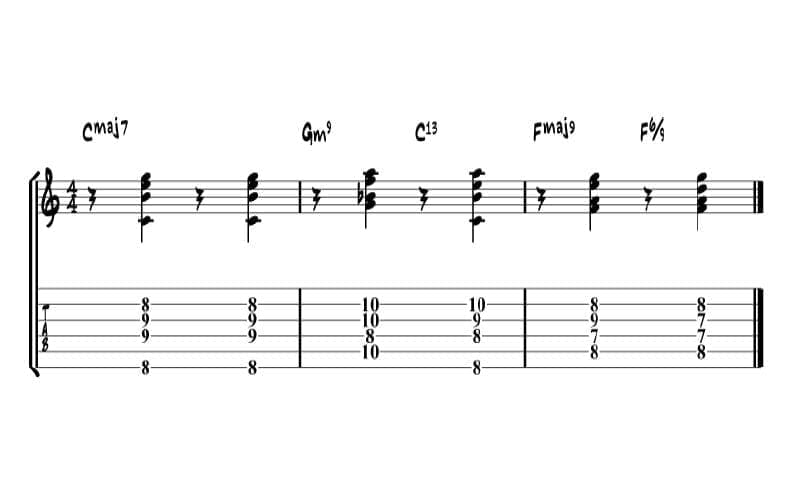
| Song Title | Played By |
| Satin Doll | Tal Farlow |
| Cherokee | Tal Farlow |
| Joy Spring | Joe Pass |
| Have You Met Miss Jones | Kenny Burrell |
| There Will Never Be Another You | George Benson |
IV to IV Minor
| Cmaj7 | C7 | Fmaj7 | Fm7 |
| Imaj7 | I7 | IVmaj7 | ivm7 |
| Em7A7 | Dm7G7 | Cmaj7 | % |
| iiim7VI7 | iim7V7 | Imaj7 | % |
Used by a myriad of jazz musicians and improvisers and by many pop artists including the Beatles, the IV (major) to iv (minor) harmonic change variation is one that every jazz guitarist needs to have under their fingers from both a comping and soloing point of view.


Famous examples include:
| Song Title | Played by |
| Moose the Mooche | Pat Metheny |
| Shaw Nuff | Barney Kessel |
| All of Me | George Benson |
| All the Things You Are | Pat Metheny |
| There Will Never Be Another You | George Benson |
Rhythm Changes Bridge
| D7 | G7 | C7 | F7 |
| III7 | VI7 | II7 | V7 |
Based on the cycle of 5ths, the bridge to ‘Rhythm Changes’ features four 7th chords moving up by a 4th with each new chord in the progression. Although only four chords are available, these changes may be hard to get to grips with, which makes them worth looking into.
Below are a few ways that you can learn playing the bridge to Rhythm Changes (in Bb major) to help you get started.
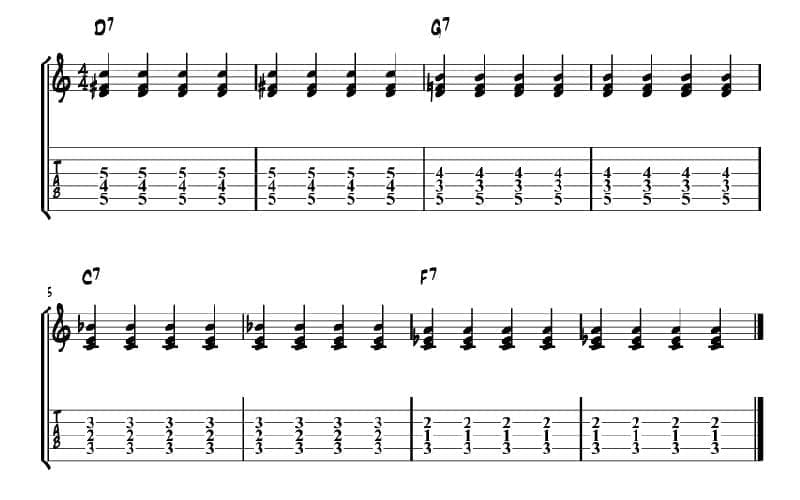

II V I Minor
| Dm7b5 | G7 | Cm7 | % |
| iim7b5 | V7 | im7 | % |
Like its major-key cousin, the minor ii V I progression can be heard in many songs from a wide variety of musicians. However, this progression includes the hard-to-play 7alt chord. Even more experienced players find this difficult, which is why it is important to explore.
Below are a few examples to introduce you to comping through this important group of 3 chords:
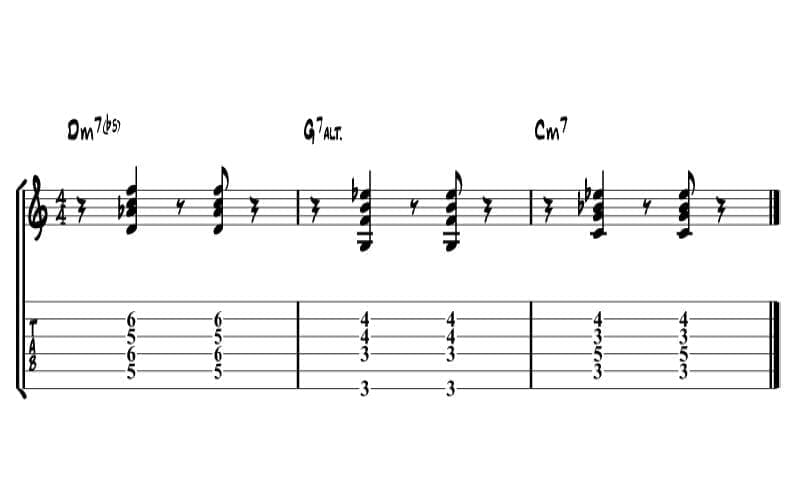

Stray Cat Strut
| Cm7 Cm7/Bb | Ab7 G7 |
| im7 im7/b7 | bVI7 V7 |
This minor-key turnaround is a progression that every jazz guitarist and even jazz pianist should be able to play with ease. From the classic tune ‘Stray Cat Strut’, these four chords can add flair to any boring minor-turnaround.

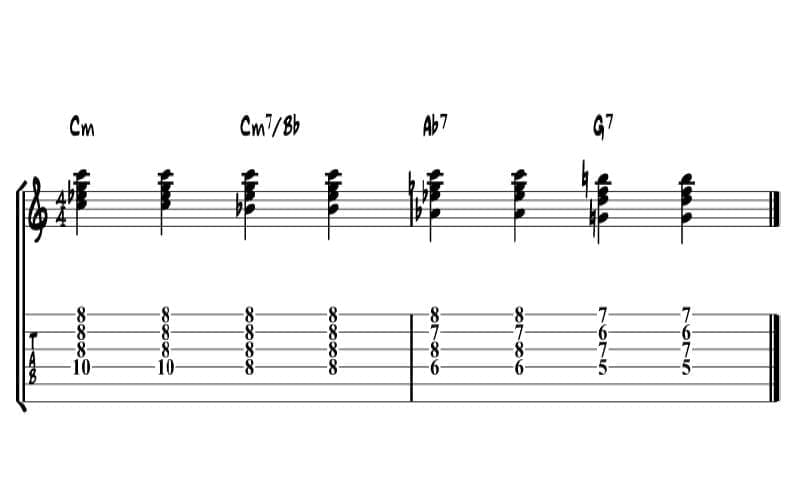
Here is a Youtube video with a more in-depth explanation of Jazz Chord Progressions
Conclusion And Advice
After going through this Jazz Chord Progressions Piano guide, you should find comping and soloing easier. Now, you have gone through some of the most important jazz chord progressions and their variations try playing some of the well-known jazz arrangements mentioned throughout this guide. For practice, try playing in different styles and different Tempos.
Every jazz guitarist should frequently study jazz and classical harmony. This should also make the process of improvising a lot easier too – just make sure you record your sessions as well. You could even come up with the next biggest jazz chord progression yourself, take a look at our guide to the Blues scale or apply your knowledge to the world of piano chords!
So, now you have learned about jazz chord progressions and are hopefully putting these tips into play and writing your own songs! Allow us to help you amplify your music, collaborate with others, and even get your music in TV, film, and more.










